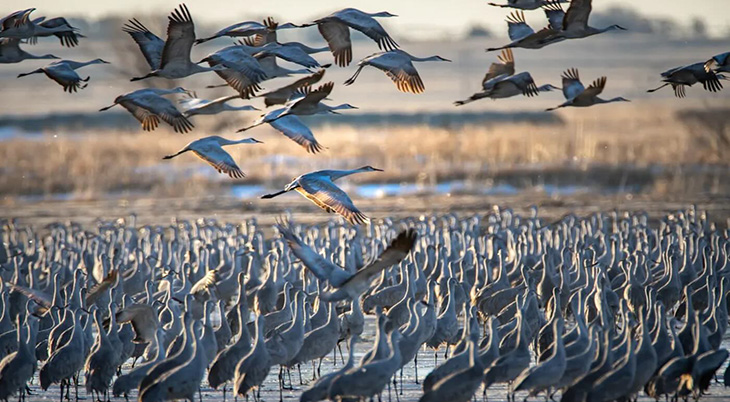

Each spring, one of North America’s greatest natural spectacles unfolds in the skies above Nebraska, as hundreds of thousands of sandhill cranes gather along the Platte River on their long journey north.
This year, however, what was meant to be a breathtaking display of avian beauty carried with it the potential risk of becoming a bird flu “superspreader” event. Fortunately, those fears have been completely alleviated, as the 2024 migration reached record numbers without a single sign of an outbreak.
Roughly three-quarters of a million sandhill cranes descended on Nebraska this spring, stopping over in the Platte River Valley for their annual layover before continuing toward breeding grounds farther north.
Official aerial surveys conducted by the Crane Trust—a nonprofit organization dedicated to protecting this ancient migration—counted an estimated 738,000 birds in the area. Experts believe even this staggering figure might be an undercount, which seems plausible when one considers the near-impossible task of tallying such a massive, constantly moving crowd of birds.
Although initial concerns were high that the highly contagious strain of bird flu H5N1 could spread to the migrating cranes from livestock or other bird populations, Nebraska’s local news outlets reported a welcome outcome: not a single dead crane was observed as the birds began moving north again.
The sandhill crane migration through Nebraska isn’t a new phenomenon. In fact, this remarkable journey has been occurring for an estimated 9 million years. Every spring, these tall, elegant birds congregate along an 80-mile stretch of the Platte River between the towns of Chapman and Overton. The region’s shallow, braided river channels provide a perfect nighttime refuge, offering protection from predators as the cranes sleep standing in six to eight inches of water.

“What makes the central Platte River valley attractive to sandhill cranes is the river that we help manage,” said Matt Urbanski, a spokesman for the Crane Trust, in an interview with KSNB’s Madison Smith.
“We will make sure that there’s not a ton of vegetation choking the river out. We’ll make sure that it can widen, so the sandhill cranes have six to eight inches of water to sit in during the nighttime.”
Sandhill cranes are among the tallest birds in North America, standing between 3 and 4 feet tall. They are easily identified by their crimson crown of feathers and a distinctive, rattling, bugle-like call that echoes across the Nebraska plains each spring. They are one of only two species of cranes native to North America, making their annual migration an especially valued wildlife event.
Earlier this year, news of over 1,000 cranes found dead in Indiana from H5N1 raised significant alarm in bird conservation circles. The prospect of a similarly catastrophic outbreak among Nebraska’s vastly larger crane gathering prompted close monitoring of the situation.
Fortunately, experts noted that the risk was minimal, as cranes traveling through Indiana and those migrating over Nebraska typically stick to rigid, separate migration routes, significantly limiting potential cross-contact.
While the Platte River provides a safe overnight resting place, the surrounding farmlands supply a convenient food source for the cranes. After centuries of adaptation to agricultural landscapes, the cranes now spend their days foraging for leftover corn kernels in the fields surrounding the river, a reliable fuel source for their long northbound journey.
Interestingly, the cranes have been drawn to this specific region for millions of years—even before the river as it exists today was fully formed. Despite dramatic changes to the landscape over time, these birds have maintained their timeless connection to Nebraska’s plains.
As the birds continue their staggered departures over several weeks, the Nebraska stopover remains one of the greatest natural wildlife displays in the United States. Thousands of visitors travel to the region each spring to witness the event, drawn by the sight and sound of hundreds of thousands of cranes filling the sky at dawn and dusk.
“There is nothing else like it in the world,” said Marcos Stoltzfus, director of the Iain Nicolson Audubon Center at Rowe Sanctuary in Gibbon, Nebraska, in an interview with News Channel Nebraska.
With both record numbers and a clean bill of health, this year’s sandhill crane migration has offered a reason for celebration among bird enthusiasts, conservationists, and Nebraskans alike. Not only was an ancient and awe-inspiring natural event preserved, but it also offered reassurance in a world often fraught with ecological concerns.
As the cranes head northward, the rivers and fields of Nebraska fall silent again—for now—until this ageless ritual returns with the promise of another breathtaking spring.
What are your thoughts? Please comment below and share this news!
True Activist / Report a typo







